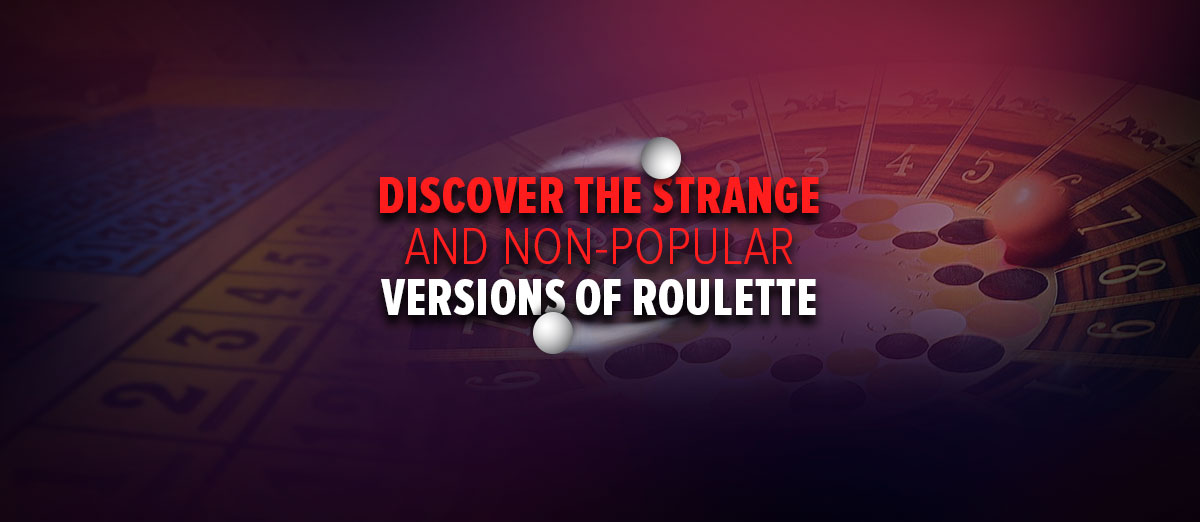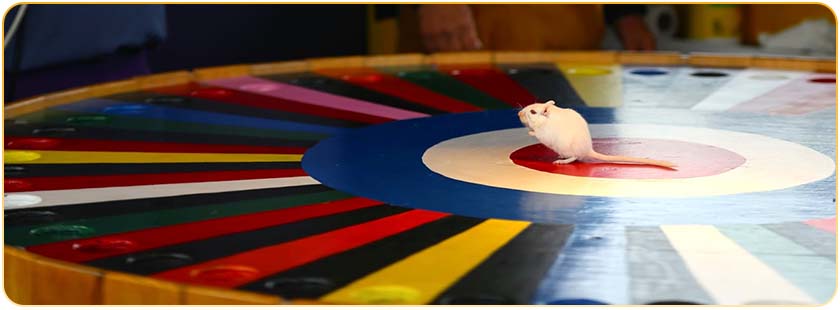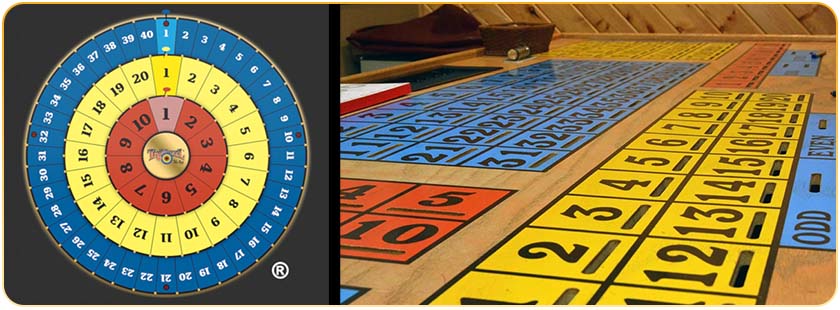Weirdest Roulette Game Versions - Characteristics and Details

Any popular game of chance has had, during its history, several strange versions that were played in casinos and other playing environments. Some of these versions were improved over time, coming to shape the actual game that is popular today. Other versions simply did not pass the test of time with respect to the supply-and-demand principle, while others persevered and are still played in land-based casinos or other public places.
Some were experimental, some were established, and some were actually an early form of the current game. This is also the case of roulette variations, which has several old versions that only the elders remember or that only some people from particular geographic zones know about.
French, European, and American Roulette are the most popular contemporary versions of roulette, but many other variations are no longer popular. These differ from the actual game and from each other by the configuration of the wheel and table, the mechanism of spinning, and generating the outcome.
Game experts categorize these games in the large category of wheel and table games, which is, of course, synonym with roulette games. In this article, we will discuss the most known non-popular versions of roulette and how their characteristics differ from the actual game.
Mouse Roulette – The Shortest-Lived Variation of the Game

The name of this game is not metaphoric. A real mouse was “employed” to participate in the process of drawing the outcomes, which were not numbers, but cards (52 cards as in a regular deck and four additional symbols).
The mouse was not any “circus effect” or element of attractiveness, but its role was actually to ensure the fairness of the game: In the 1930s it was a common thing for casinos to use crooked or biased wheels, with all kind of cheating strategies – magnets hidden in the table, inclination of the wheel, and so on.
With this mouse version, the inventor of the Mouse Roulette (Everett MacDonald) or also known as Rat Roulette aimed at gaining the trust of the casino’s clients. There were 56 holes surrounding the wheel, each one connected to a glass trap. When the wheel was spun, the mouse was dropped into the center and people waited for the mouse to enter a glass trap, which determined the winning outcome.
The bets offered were similar to roulette bets:
The single-card bet at mouse roulette has an expected value of EV = 49×(1/56) – 1×(55/56) ≈ – 0.1071. Hence the house advantage of the mouse roulette was 10.71%, more than twice as high as the house edge of the American roulette.
Mouse roulette has been launched at Harolds Club in Reno, Nevada, on May 15, 1936, and lasted only one night. However, a recent TikTok video featuring the popular TikToker @the_alaska_guy at a US funfair has reignited interest and sparked debate in the long-forgotten game.
@the_alaska_guy #alaska #outdoors #alaskastatefair #games #gamble #gambling #sourdough #single #beard ♬ Ring of Fire - Johnny Cash
La Boule and French Bull Roulette

La Boule and French Bull, not to be mistake with French Roulette, are versions of roulette using a rubber ball tossed into a wheel or tray where the holes are associated with one-digit numbers: 0 to 9.
The versions are of French origin, though French Bull’s widest spread may have been in the casinos of Southeast Asia.
La Boule uses a wheel with 18 holes, where each number from 1 to 9 has two holes allocated to it. The numbers 1, 3, 6, and 8 are black, while 2, 4, 7, and 9 are red. Number 5 is yellow and has a role similar to that of the zero in actual roulette. The payout schedule is as follows:
Only two payoffs are available and that makes La Boule the simplest version of roulette. The even money bets has the expectation EV = 1×(4/9) – 1×(5/9) = – (1/9) ≈ –0.1111, as well as for the bet on single number, so the casino holds an 11.11% house advantage (edge), more than double the house advantage of the American roulette.
French Bull replaces the traditional wheel with a rectangular tray having 67 numbered pockets, in one of which the rubber will land. The pockets are numbered with numbers from 0 to 9, which are not equally distributed in the tray: numbers 1-7 appear 7 times each, while 8, 9, and 0 only 6 times.

French Bull roulette offers four types of bets – a single-number bet and bets on designated sets of three numbers, as follows:
Since the numbers are not equally distributed, their probability of occurrence is not equal for all of them (like in standard roulette), although the payout odds are the same for the same type of bet. This asymmetry is an atypical feature for a casino game and its rationale is unknown.
Obviously, a single bet on 0, 8, or 9 is better for the player than any single bet on any of the numbers from 1 to 7. The bet on 1, 4, 7 is better for the player than any other 3-number bet. The expected value and house advantage (HA) for each particular bet is different:
What Is Big Six Wheel Roulette?

The Big Six Wheel, or simply put the Big Wheel version of roulette is actually a large wheel (six feet or more in diameter) divided into 54 sectors. Every sector has allocated a symbol, usually an amount of currency or casino logo. There are several versions of this game and the most frequently used symbols and their distribution is in the next table, along with the probabilities of occurrence:
Players bet on the occurrence of the symbols. The winning symbol is determined as the symbol found at the top of the wheel when the wheel stops from its spin (it is indicated by a flexible arrow or strip called clapper).
As described, this game resembles the traditional Wheel of Fortune, played at fairs and carnivals, but also in television shows and on the casino floor. One may fairly call it a wheel-of-fortune game rather than casino roulette version (all the more so as there is no ball).
Payoffs of the Big Six Wheel are as follows: Currency symbols pay their face value on a win and logo symbols pay off usually at 40 to 1.
The face-value payoff is challenging for the player and is not met in other versions of roulette: You won’t bet with a stake higher that the minimal amount on the currency symbols ($1) for benefitting by the payout odds in case you win, however this minimal stake leads to a low profit rate. This fact makes you wonder whether it would be better to bet on a logo with that stake, which however has a very low probability.
The player may also consider placing multiple bets for one spin, however this assumes precise calculations before choosing the bets in regard to the overall possible profit and loss (just like when placing combined bets in standard roulette).
In terms of expected value, the best bet in Big Six Wheel is the bet on $1, with an EV = $0.1111 (you may expect to lose 11 cents for every dollar bet), giving a house advantage of 11.11%. However, this bet – although ‘safe” – is also associated with the lowest profit rate. For the other bets, the house advantage ranges between 16.67% and 24.07%.
The standard game and versions of the Big Six Wheel, such as Lucky Big Wheel, Dream Catcher, Federal Wheel, Mystery Card Bonanza, and Pokette (the last two having cards as symbols on the wheel instead currency symbols) are mostly played in casinos across the United States and Australia rather than in Europe or Asia.
It is worth noting that electronic versions of the game also exist in physical locations and in online live casino, which is a sign that the game is still popular in present days.
Minnesota Tri-Wheel Roulette – Characteristics and Payouts

Minnesota Tri-Wheel is known as in the category of paddlewheel games and its wheel consist of three concentric rings with numbers on them: The innermost ring is orange and divided into 10 sectors numbered 1 – 10; the middle ring is yellow and has sectors numbered 1 – 20; the outside ring is blue and numbered 1 – 40. The three rings rotate independently when the wheel spins and a clapper determines three winning numbers, one per ring.
Players may bet on a single number on a ring (on one or more rings), on lines of numbers on the yellow or blue rings, or on Odd or Even on the blue ring, in the layouts as shown in the image above. Unlike in standard roulette, players may not place bets in the interior of the layout covering more than one number.
Rows labeled A-D in the image show the sets of numbers (ten numbers each) that each line consists of in a Line bet in the blue layout. Rows labeled E-I show the sets of numbers (four numbers each) that each line consists of in a Line bet in the yellow layout. The payout odds for each bet along with its probability are noted in the table below:
An immediate observation is that the Odd/Even bet appears to have a zero house edge (half of numbers are even and half odd, and payout odds are ×2), what in theory is called a fair bet.
But this is not the case, as the house still retains an edge by placing six stickers on six blue numbers (placed evenly around the ring) on which Odd/Even bets all lose. With this rule, the expected value of the Odd/Even bet is: EV = 2×(17/40) – 1 = –0.15, which gives a 15% house advantage.
For the single-number bets, house advantage is as follows:
- On the blue ring: HA = 12.5%;
- On the yellow ring: HA = 15%;
- On the orange ring: HA = 20%.
With such high house advantages, Minnesota Tri Wheel (authorized in 1987) looks like a game to avoid, however the game is actually played across the state of Minnesota, but not in casinos.
The reason is that Minnesota state law is very restrictive in games of chance allowed at charitable fundraisers and for casual play in bars and restaurants. The high HA is thus justified, as the game is intended as a charitable fundraiser.
Commonalities and Differences of the Roulette Versions
Games of chance have their own market as any other product we know. The top-branded or successful products evolve in the market by developing from time to time versions of the original product. Variation is a sign of popularity and the existence of several bizarre roulette variations ascertains the popularity of this casino game. Yet there is a difference in the parallel we made between a game of chance and a product from other industry.
While beyond design and appearance changes might not affect much the original purpose, functioning, or the returns of a say, housekeeping product, any parametric variation of roulette may change dramatically the returns of the game.
Just one zero added on the wheel makes American Roulette to double its house advantage relative to the European variant, any change in rules and configuration makes any version of the table game to differ to the others in their mathematical aspects, as we saw in the few roulette versions described.
But, as it happens in gambling, players are not exclusively concerned about odds, expected value, and house advantage, but they also look for a pleasant experience – and variation contributes to this pleasure. Under this principle, no one can exclude theoretically the possibility that a non-popular version of roulette to become in time more popular than the standard version.





Review this Blog
Leave a Comment
User Comments
comments for Weirdest Roulette Game Versions - Characteristics and Details